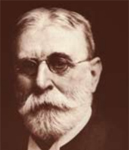 B.B. Warfield
B.B. Warfield
“In the beginning was the Word, and the Word was with God, and the Word was God.” (John 1:1)
John’s gospel does not differ from the other gospels as the gospel of the divine Christ in contradistinction to the gospels of the human Christ. All the gospels are gospels of the divine Christ. But John’s gospel differs from the other gospels in taking the divine Christ as its starting-point. The others begin on the plane of human life. John begins in the inter-relations of the divine persons in eternity.
It is interesting to observe how the brief prefaces of the several gospels reflect the tone and chief engrossment of the gospel to which each is affixed. Luke, the scholarly historian, begins his gospel with a series of finely turned clauses, designed to inspire confidence in the exactness of his information and the accuracy of the narrative in which he recounts the life-history of the founder of Christianity. Mark, the man of action in a single brisk line, presents his as an account of how the great religious movement in which he was bearing his part took its rise in an intervention of God in Palestine. Matthew opens his by casting his eye back on Israel’s past and tracing the continuity of the history he is narrating with the whole divinely guided course of Israel’s development. These all begin with the man Jesus, whom they set forth as the Messiah in whom God has visited his people; or rather, as himself, God came to his people according to his promise. The movement in them is from below upward; from the man of God’s appointment to the King of all the ages. The movement in John, on the contrary, is from above downwards. He takes his start from the Divine Word, and descends from him to the human Jesus in whom he was incarnated. This Jesus, say the others, is God. This God, says John, Became Jesus.
The fundamental purpose of the preface which John has prefixed to his gospel is, in a word, to account for Jesus Christ. In undertaking to spread before his readers the life-story of this wonderful man, he feels that the marvel of it requires some preliminary statement about his real nature, so that the drama he is to unroll may not distress and puzzle the reader. He says, in effect, that the man Jesus – what he was, what he taught, what he did – is to be understood only by bearing in mind, from the beginning, that he was God manifested in the flesh. Those who looked upon him, listened to him, companied with him, and watched his going in and out among men, saw in him a glory as of an only-begotten from the Father; and John would fain depict him as they saw him, that his readers, too, may believe. He must, then, begin by telling them plainly who and what this marvellous man was. From this starting-point only will the story he has to tell develop itself smoothly, without entailing numerous pauses for explanation or justification. From this starting-point only can it be read without doubts and hesitation.
Precisely what John, in this preface to his gospel, presents Jesus as really being, we repeat, is God manifested in the Flesh. His interest is not in what Jesus once was so much as in what Jesus continuously was. His purpose is to prepare his readers for the manifestations of deity which they will meet in the story of Jesus’ life and teaching; to make these things seem natural in this man, and thus to enable them to read about them simply and without shock of surprise. He, therefore, wishes to tell them plainly at the outset that this Being of whose life on earth they are to read is no mere man, but just God manifest in the flesh.
The language in which John does this is all his own. He draws an Old Testament symbolism, and tells us that what men saw in Jesus was the true Shekinah – the glory of God dwelling in the flesh of Jesus as in its true tabernacle, and visible there to every seeing eye. In somewhat less figurative language, he declares that in Jesus Christ men saw all that God is. No one, indeed, has ever gazed directly on God; but in Jesus Christ they have had God completely unfolded to their view. Says John, it is Christ who has “declared him” – literally, has “exegeted” him to men’s sight. Accordingly, he calls him not simply God – for that would express only what he is in himself, and John wishes to bring out also what he is to us; so he refers to him as “the Word,” and “the Light;” God, not merely in himself, but in his manifestations – the manifested God.
This does not mean that Jesus Christ, though standing in a high and unique relation to God, is yet something less than God. It means that he is all that God is, yet God as manifested. He is declared plainly to be God. He is asserted to have subsisted from eternity. He is announced as the actual creator of all. He is represented as the source of all the light and life that is in the world; and of all the restoring influences that play upon this sinful world. He is proclaimed finally as God only-begotten, who abides in the bosom of the Father, while yet manifesting his glory on earth.
Such is the Being whom, John tells us, we must recognise this Jesus Christ to be. Only by recognising him as God in the flesh, he tells us, can we understand the life he lived and the work he did.
This is the significance of the preface to John’s gospel.
____
(From an article entitled “John’s First Word” found in the Shorter Writings of B. B. Warfield.)
